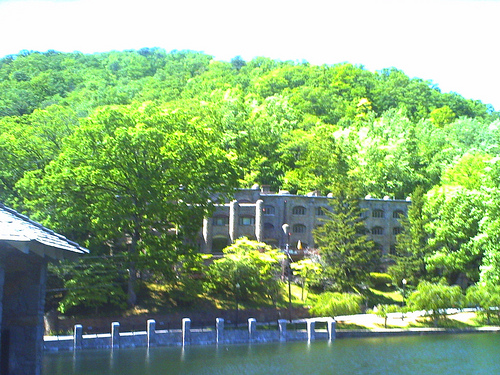Montreat
 In 1897 the Mountain Retreat Association formed one of the earliest mountain religious resorts in North Carolina. John C. Collins, a Congregational minister from New England, wanted to create a religious retreat for church members in the North Carolina mountains. He formed the Mountain Retreat Association in 1897 and purchased 4,000 acres east of Asheville near Black Mountain. Over the next ten years, the new retreat called Montreat (a name derived from the association's name) saw the construction of several cabins and the Montreat Hotel. Montreat hosted a series of conferences but was always on the edge of financial collapse.
In 1897 the Mountain Retreat Association formed one of the earliest mountain religious resorts in North Carolina. John C. Collins, a Congregational minister from New England, wanted to create a religious retreat for church members in the North Carolina mountains. He formed the Mountain Retreat Association in 1897 and purchased 4,000 acres east of Asheville near Black Mountain. Over the next ten years, the new retreat called Montreat (a name derived from the association's name) saw the construction of several cabins and the Montreat Hotel. Montreat hosted a series of conferences but was always on the edge of financial collapse.
In 1906 the Presbyterian Synod of North Carolina, led by Charlotte minister James R. Howerton, purchased the property for use as a retreat for Presbyterian Church members in North Carolina and from across the South. Despite some improvements in infrastructure, Montreat's financial prospects continued to decline. In 1911 fortunes began to change with the appointment of Robert Campbell Anderson to run the resort. The former pastor of First Presbyterian Church in Gastonia, Anderson initiated a highly successful capital campaign, a building program, and a promotional program designed to attract more visitors to Montreat. He also wanted the conference center to play a larger role in mission work, a goal he accomplished through numerous training conferences and the establishment of Montreat Normal School.
Apart from its institutional role, Montreat has had an important place in the church life of southern Presbyterians. The retreat has served as a testing ground for new doctrinal ideas and hosted integrated meetings that fostered racial justice within the Presbyterian Church. Women also have found increased roles in church life through participation in events at Montreat. In 1934 Montreat Normal School became Montreat College, a four-year institution providing instruction to future generations of Presbyterian leaders. As early as the 1920s, Montreat served as a repository for archival materials related to southern Presbyterianism. Now called the Presbyterian Church (USA) Department of History (Montreat), the archive assists churches in record preservation and encourages scholarly research in Presbyterian history and theology. Montreat has also become a retirement community for Presbyterian leaders, a reflection of the important place the retreat has in the hearts of the faithful.
References:
Robert C. Anderson, The Story of Montreat from Its Beginning, 1897-1947 (1949).
William Bean Kennedy, "Montreat: Education Center of the Presbyterian Church," American Presbyterians: Journal of Presbyterian History 74 (Summer 1996).
Mary-Ruth Marshall, "Handling Dynamite: Young People, Race, and Montreat," American Presbyterians: Journal of Presbyterian History 74 (Summer 1996).
Additional Resources:
Montreat Conference Center: http://www.montreat.org/
Image Credit:
Montreat. Image courtesy of Flickr user Patrick Talbert. Available from https://www.flickr.com/photos/skibler/4595243549/ (accessed June 7, 2012).
1 January 2006 | Starnes, Richard D.